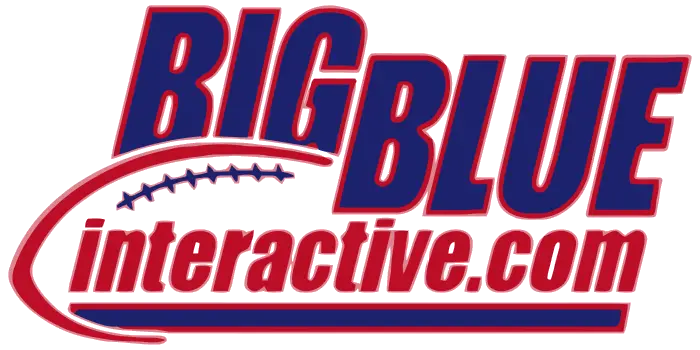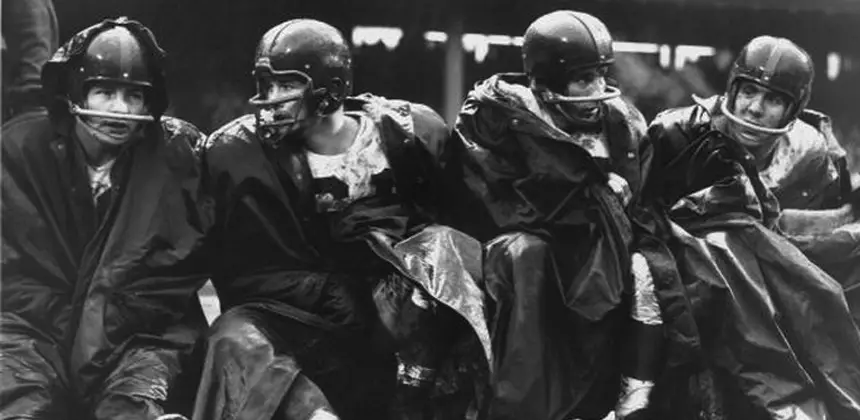By Larry Schmitt with contributions from Daniel Franck and Dr. Bruce Gilbert
The 1956 season was a watershed moment for football in New York. Filled with potent portent, the campaign proved to be the penultimate piece of the puzzle for the ultimate explosion of pro football’s popularity with the general public, the event horizon for which was crossed on December 28, 1956 when the Giants met the Bears for the NFL Championship. Almost three-and-a-half decades of groundwork created the proper conditions for the spontaneous and unpredictable happenings that captivated an audience and spawned the new national pastime – Football Sunday. Legions of fans would congregate for tailgate parties at their local stadiums or have the game of their favorite team broadcast right into their living room. Then fans would reconvene at Monday-morning quarterback meetings at their watercoolers on Monday.
The first step was short in distance but profound in stature. NFL Commissioner Bert Bell received an inquiry from a Texas-based oil syndicate about the availability of the league’s New York franchise. The Mara family would later suspect the offer came from Murchison brothers, who would one day start the Dallas Cowboy franchise. Bell notified Giants owner Tim Mara that a $1,000,000 offer had been made, contingent on the home games being staged at Yankee Stadium, rather than the Polo Grounds. Mara declined, but figured if his team was worth that much at Yankee Stadium that the team should make the short trip across the Harlem River to the larger and more prestigious venue.
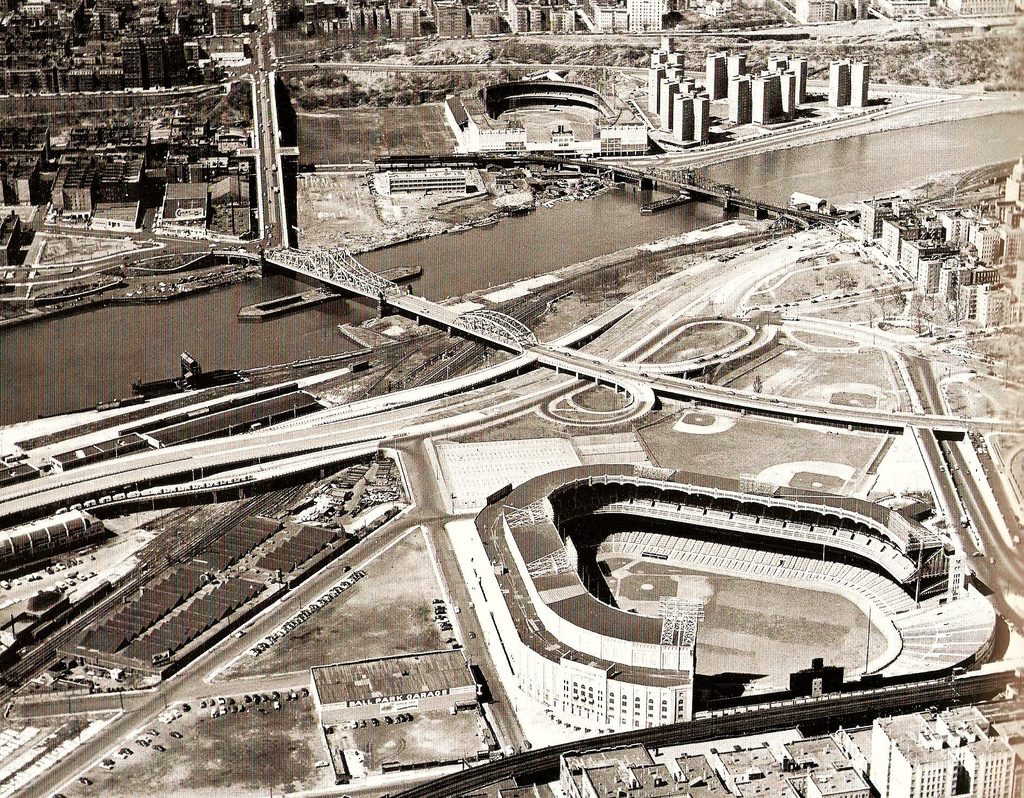
Yankee Stadium and Polo Grounds (circa 1954-57)
The once venerable Polo Grounds, the Giants home for their first 31 seasons, had suffered from a lack of upkeep and was gradually falling into a state of disrepair. Although Mara’s team rarely enjoyed sellout crowds, the growth potential was also attractive. The Polo Grounds standard seating capacity was 55,000 while Yankee Stadium was just over 62,000. [These figures are for the standard baseball configurations. Both stadiums were often equipped with temporary seating along the sidelines for football games which increased ticket availability.]
The Polo Grounds had been the only home field the Giants had known to that point. The Giants had a tremendous run during their residence at the Polo Grounds, including an overall regular season record of 132-62-11 – which included one game in 1949 as the visiting team against the New York Bulldogs. They had won eight Eastern Division titles, hosted five post-season games and won two of their three NFL Championships there in 1934 and 1938. Although there was no post-season in 1927, the Giants won the pivotal game for the championship against the Chicago Bears 13-7 on November 27 at the Polo Grounds as well.
The announcement to move to Yankee Stadium was made on January 26 and was attended by Bell and Yankees General manager George M. Weiss. Bell emphasized the league’s need for stability of a franchise in New York as the Giants signed a 20-year lease. The future of the Polo Grounds was very uncertain; current speculation had the baseball Giants possibly moving to Minneapolis by 1962 when their lease expired. Charles Feeney, president of the baseball Giants, was also in attendance and said, “We had a long and pleasant association with the Football Giants; we are sorry that they’ve left the Polo Grounds but we wish them nothing but luck in the future.”
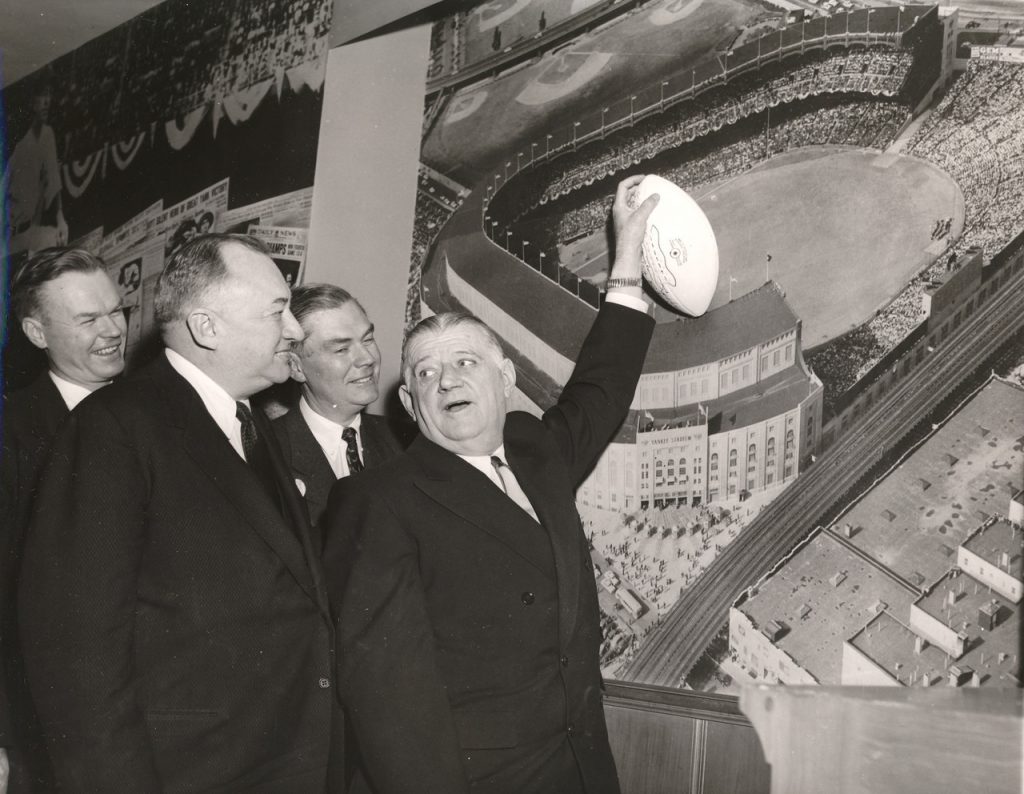
Wellington Mara, George Weiss, Jack Mara, and Bert Bell (January 27, 1956)
The Football Giants move to Yankee Stadium monumentally altered the perception of the team. While Owner Tim Mara emphasized that the team name would remain the Giants with the change in venue, the Giants went so far as to incorporate the structure into their official team logo. The quarterback who had towered among Manhattan’s skyscrapers since the mid 1930’s was now set inside Yankee Stadium. However, the Football Giants remained secondary in the consciousness of the metropolis’ citizenery until the close of baseball season in mid-October.
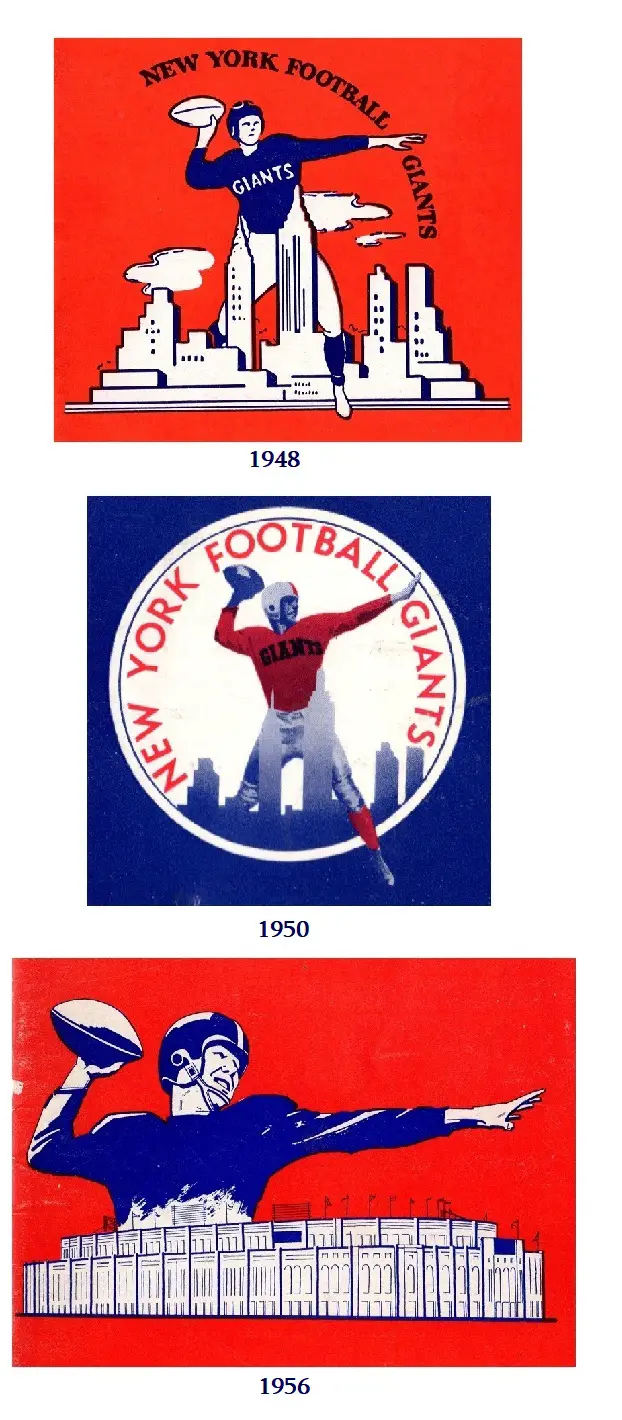 That is with good reason, as the Yankees, Brooklyn Dodgers and baseball Giants had won every World Series since 1948. In fact, five of those seven were “Subway Series” featuring the Yankees against either the Giants or Dodgers. The 1956 season would make it six of eight as the Yankees played the Dodgers again. While the Football Giants toiled in the shadow of baseball, pro football as a whole had made significant progress not only in closing the gap with college football in terms of popularity, in many markets (New York included) the professional game had already eclipsed it.
That is with good reason, as the Yankees, Brooklyn Dodgers and baseball Giants had won every World Series since 1948. In fact, five of those seven were “Subway Series” featuring the Yankees against either the Giants or Dodgers. The 1956 season would make it six of eight as the Yankees played the Dodgers again. While the Football Giants toiled in the shadow of baseball, pro football as a whole had made significant progress not only in closing the gap with college football in terms of popularity, in many markets (New York included) the professional game had already eclipsed it.
Exponential Exposure
While the NFL had made organizational and legislative changes to make the pro game more appealing to fans, there is no debate that the single biggest reason for the proliferation of pro football as the sport that dominates America’s landscape is the advent of television.
Radio was the first medium to extend pro football to the masses in the 1930’s. The first nationally-broadcast game via radio was the Thanksgiving Day contest between the Chicago Bears and Detroit Lions in 1934. The first television broadcast was between the Brooklyn Dodgers and Philadelphia Eagles from Ebbets Field on October 22, 1939. The telecast was only available in New York and Schenectady. The 1940 Championship Game between the Chicago Bears and Washington Redskins was the first title game nationally broadcast via radio.
Teams were left to their discretion with televising their games with their local television affiliates, and ultimately this would lead to a tremendous revenue inequality. But in the early days there were few televisions available and the medium was still very much experimental. Nobody at the time conceived the magnitude of its underlying potential. Most teams chose to broadcast their away games, but there were some exceptions. In 1946, the Philadelphia Eagles, Los Angeles Rams and the Chicago Bears each televised a handful of selected home games, while the Giants televised their entire home schedule (to approximately 8,000 TV sets), and their attendance at the Polo Grounds increased 18% over the prior year.
In 1948, Bell negotiated the first league-wide television contract, which was for select regular-season games and the NFL Championship Game. Television money now became an essential source of income for all teams. The 1948 Championship Game between Philadelphia Eagles and the Chicago Cardinals was the first televised championship, although it was limited to the two team’s local markets. In 1950, the Los Angeles Rams became the first NFL team to televise all of its games – home and away. The unforeseen consequence of home attendance dropping was then first realized as there were significantly more television households in America. The NFL adopted the blackout rule in 1951 – no NFL games were broadcast to a market where an NFL game was being played on that same day. Bell reasoned, “You can’t give fans a game for free on TV and also expect them to pay to go to the ballpark.”
The 1951 season also saw the first coast-to-coast telecast of the NFL Championship Game, between the Cleveland Browns and Los Angeles Rams, by the Dumont Network. From 1950 through 1953, both ABC and Dumont broadcast weekly pro football highlight programs nationally. Most teams began programming their own weekly shows locally as a supplement to their games on Sunday. Chris Schenkel was the Giants play-by-play announcer for games, a role he would hold for over a decade. Steve Owen hosted the Giants first coaches’ show in New York, and became the franchise’s first familiar face.
During this time, it was noted that the attendance for college football and major league baseball was experiencing a state of decline, but pro football’s attendance was steadily ascending. The stability and prosperity sought by professional football’s founding fathers three decades earlier was now finally materializing. For the first time, public demand was coming to the NFL. The response from the league was the first prime-time, live sporting event series. Every Saturday night from 1953 through 1955 an NFL game was broadcast across America. Some college purists protested that the NFL was hurting their game, but Bell’s retort told how the tide had turned for good, “We’ve got no quarrel with the colleges. Our Saturday night and Sunday games don’t hurt their gate as much as they claim. We have their best interest at heart. They’re our farm system.”
In 1955, NBC purchased the rights to broadcast the NFL Championship Game and would keep it through the rest of the decade. In 1956 after DuMont went broke, CBS entered into a contract and became the first network to televise NFL games to selected television markets across the nation, as long as they did not conflict with the home team. The first nationally-televised Thanksgiving Day game took place between Green Bay and Detroit Lions that season. This tremendous increase in exposure not only introduced the NFL to a larger fan base, it gave the league a significant boost in stature. The most significant change was the cash brought in by the CBS contract. The prosperity seemed irresistible as stadium attendance continued to climb.
Gate receipts increased and sellouts became more common as community support became more robust. Pro football attendance increased to over 70% during the 1950’s. The average gate of 23,356 in 1950 grew to 43,356 in 1959, which represented 90% of the league’s capacity. Having surpassed college football, pro football was narrowing the gap on major league baseball as well. While legal issues on how the new television medium would be utilized were a behind-the-scenes distraction for several years, the problems would be worked out in the next decade.
The biggest leap in attendance occurred between 1956, with an average attendance of 35,356, and 1957, with 39,393. This was undoubtedly helped by the Giants successful season in a larger stadium. TV had an impact too. Head Coach Jim Lee Howell, who had been with New York as a player and coach since 1937, said, “We had a great game all the time, but it wasn’t exposed to many people outside of the cities where we played. Television has helped, it has made more people aware of the game.”
Final Touches and Finishing Business
The Giants had progressed each of the past two seasons under the new regime of Howell and his two brilliant assistant coaches, Tom Landry and Vince Lombardi, and a bolstered roster after a dreadful collapse in 1953. Lombardi brought toughness and precision to the Giants offense while Landry infused ingenuity and innovation to the defense. Each brought a different style to coaching. Lombardi would pound a blackboard with his fist in frustration to make his point, while Landry would simply, coldly stare down the object of his dissatisfaction without raising his voice or gesturing with his arms.
Following a disappointing start in 1955, the teaching and drilling finally delivered returns during an impressive 5-1-1 run to finish the year. The loss and tie were to the league champion Browns, and the final win of the season was against the Western Conference champion Lions in Detroit, a team the Giants had always struggled against.
Despite the upturn in fortunes and the retirement of nemesis Otto Graham from Cleveland, most prognosticators were lukewarm about the prospects for the 1956 New York Giants. New York had gone nine seasons without an appearance in the championship game, their longest stretch since the league had split into divisions in 1933. Perhaps the only people optimistic about ending the championship drought were the Giants players and coaches themselves.
Training camp was a long and grueling affair for the 53 players who reported to compete for the 33 roster spots. Eight full weeks of training and conditioning at a high school field in Winooski, Vermont, that was interspersed with six dates traveling the country to play pre-season contests at neutral sights. The NFL was exploring new ground for potential expansion while also bringing games to fans who had only begun watching on television. Five of the Giants six game were played in non-NFL cities and they stretched coast-to-coast from Boston to Seattle and Portland, Oregon and south to Dallas and Memphis.
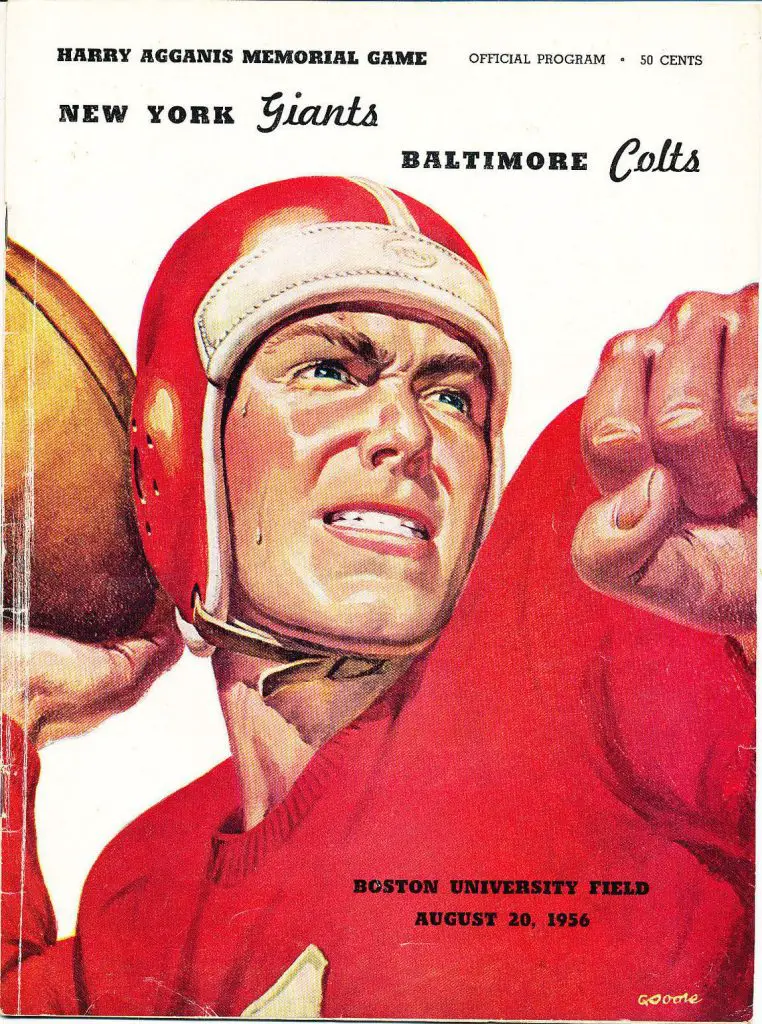
New York Giants – Baltimore Colts Game Program (August 20, 1956)
On offense, Lombardi honed his version of the T-Formation sweep. The Giants had a rugged and battle-tested offensive line, led by All-Pro Roosevelt Brown at left tackle, that emphasized athletic ability and coordination. New York’s philosophy was ball control and their bread-and-butter plays were 47 Power, which featured right halfback Frank Gifford, and 26 Power, which featured left halfback Alex Webster. They were essentially the same play directed to opposite sides of the line. On occasion, fullback Mel Triplett plunged straight into the line.
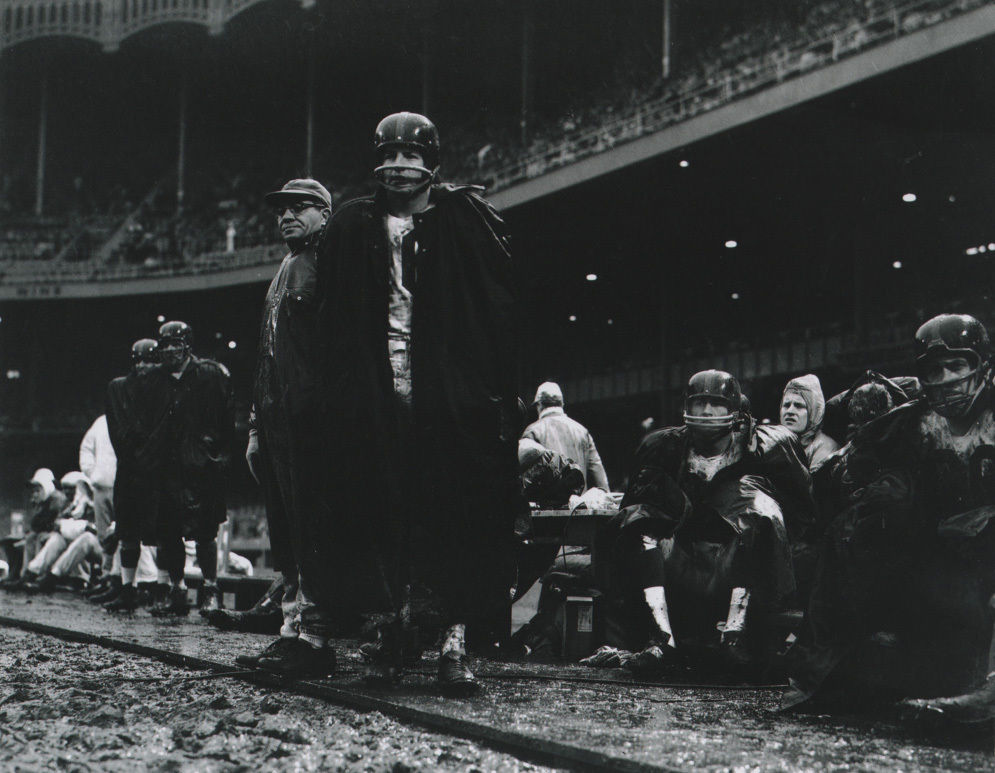
Vince Lombardi and Frank Gifford, New York Giants (December 9, 1956)
Offensive assistant Ed Kolman said, “We are playing the percentages in attempting to get modest but consistent gains on each run. If we gain three or four yards a play, we control the ball. And when we are controlling the ball, the other side can’t very well score.” Howell said, “It was almost like the old Single Wing days. What a difference it made in the Giants that year.”
Underscoring the Giants being a run-first team, they employed a unique two-quarterback system where Don Heinrich started the games and veteran Charlie Conerly came off the bench at some undetermined point depending on the ebb and flow of that particular game. Despite being the de facto backup quarterback, teammates and coaches held Conerly in the highest esteem. Gifford said, “I’ve never met a quarterback with less of an ego. Charlie called all his own plays and was the kind of quarterback who wanted information brought back to the huddle. He knew that no quarterback could see everything going on downfield. He respected his guys and made each of them part of the play-calling process.”
Sam Huff said, “Conerly was never a great pure passer, but he was a precise, control-type quarterback, methodical with a great feel for the game. He was a quiet guy too, and he was definitely a leader on that team. But he led out on the field, not with his mouth, and he was the toughest old bird you’ll ever see.” Howell said, “Charlie Conerly was our great quarterback, our meal ticket all the way through. He was a great competitor and admired by his teammates.”
When the ball was in the air, the primary targets were end Ken McAfee and flanker Kyle Rote, who were backed up by former starter Bob Schnelker. Occasionally the passes came from the arm of Gifford, who was deadly with the option pass. Gifford spent time under center during camp. According to Coach Howell, “He’s practicing strictly for experience. He does too much at halfback to change now.” Exhibiting his seemingly unbounded ability, Gifford also started the season as the Giants place kicker on field goals and point-afters. Strong-legged rookie punter Don Chandler handled the kickoff duties.
Nevertheless, with a blend of young talent and veteran leadership, the defense was New York’s dominant platoon. Strong defense had been the hallmark of the great Giants teams ever since Steve Owen took over as head coach in 1931. Landry, having played as an All Pro and coached under Owen, proved to be as least as innovative as his mentor, if not more so.
There still were different perceptions regarding offense versus defense in the NFL. The players who put points on the scoreboard were the well-paid desired commodities. The papers printed the names of the offensive starters only, even though the two-way 60-minute player was a diminishing breed. The Giants rosters typically were composed of two-thirds offensive players, with one-third devoted to defense. Most of the top draft choices, Travis Tidwell in 1950, Rote in 1951, Gifford in 1952, Joe Heap in 1955, and Henry Moore in 1956 were devoted to the offense. When Lombardi became the offensive coach he had other offensive assistants, Landry when he retired and became a full-time coach in 1956 was a defensive army of one in the locker room. And within that locker room the offense had the bigger meeting area while the defense met in the small, desolate and dank regions of the stadium.
What Landry had at his disposal were ways to effectuate change. To his players he used the disrespect to breed a collective sense of pride and purpose to be unleashed against the pampered and proper glamor boys of the offense. He also used the respect Wellington Mara had for him as well as the deference Jim Lee Howell gave him as permission to bring in a group of defensive players with the intellect and instincts for the game that Landry demanded.
Look at the moves the Giants made in the 1955-1956 offseason. Of the ten new players who made the Giants final roster, most were on defense. The middle rounds of the draft brought in Sam Huff, who had played offensive guard in college but was converted to linebacker, and defensive end Jim Katcavage who also played offensive end at Dayton. Both would be significant contributors to the “Coordinated” 4-3 defense Landry had been refining over the prior two seasons.
The predominant defense in the early and mid-1950’s was the 5-2 alignment. There were several variations, with the most popular being the Eagle Defense, popularized by Earle “Greasy” Neal in Philadelphia in the late 1940’s, and Bud Wilkinson’s Oklahoma Defense. The defining characteristics of the two were the deployment of the linebackers. What they had in common were the middle guard (today known as the nose tackle) being nose-to-nose with the offensive center and the defensive ends lined up outside the offensive tackle and tight end. The Eagle Defense set the linebackers in the gaps between the defensive tackles and ends, which put tremendous pressure on the interior of the offensive line. The Oklahoma defense moved the defensive tackles out a gap and had the linebackers flanking the middle guard. Landry’s Coordinated Defense took the best parts of both of these and assimilated it into a 4-3 front with the backfield concepts of Owen’s Umbrella Defense (essentially what is today known as a Cover 2).
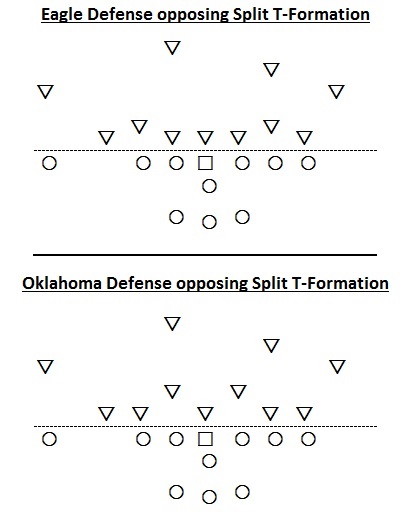 What really set New York apart from the competition was Landry’s obsessive analysis of opponent’s tendencies – “frequencies” as he termed it – regarding personal, formation, field position and down and distance. Every man on the Giants defense had a gap or zone responsibility that needed to be honored for the scheme to work. The days of whip-the-man-in-front-of-you-and-chase-the-ball were over.
What really set New York apart from the competition was Landry’s obsessive analysis of opponent’s tendencies – “frequencies” as he termed it – regarding personal, formation, field position and down and distance. Every man on the Giants defense had a gap or zone responsibility that needed to be honored for the scheme to work. The days of whip-the-man-in-front-of-you-and-chase-the-ball were over.
The key position was what Landry called “the quarterback of the defense” or middle linebacker. The role required someone tough enough to handle the pounding of charging fullbacks and halfbacks on running plays, athletic enough to cover the middle zone and outside flats on passing plays, and intelligent enough to call the defense in the huddle, read the offense’s pre-snap keys, diagnose its intentions and call a shift or audible to get his unit in the proper position to defend.
Landry’s man was Huff, who spent time during a frustrating training camp playing on both lines. During the preseason he was moved permanently to the defensive platoon, and while regularly playing tackle, he occasionally received a few snaps at middle linebacker in relief of starter Ray Beck who struggled with an ankle injury.
Huff said of Landry and his concepts years later: “It was really simple when you think about it. We’d have the ‘Inside 4-3’, where the defensive tackle would shut off the middle and the linebackers would pursue to the outside, or we’d go to the ‘Outside 4-3’, where the tackle would angle outside and I would come up the middle and make a play in there, or catch the play from behind. All the years we played, that’s all I ever did. We got so good at it, it became almost second nature to everyone on the unit. That first year, Landry called the signals.”
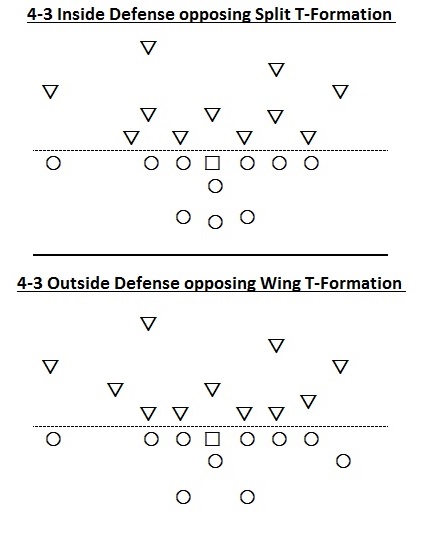 Some of the teams that played the 5-2 defense would occasionally call on an athletic middle guard, such as Cleveland’s Bill Willis and Chicago’s Bill George, to line up in a two-point stance and drop into coverage after the snap. Landry’s 4-3 defense had Huff lined up at true linebacker depth, approximately three yards off of the line of scrimmage, where he could read the offensive backfield and determine where the play would most likely be going.
Some of the teams that played the 5-2 defense would occasionally call on an athletic middle guard, such as Cleveland’s Bill Willis and Chicago’s Bill George, to line up in a two-point stance and drop into coverage after the snap. Landry’s 4-3 defense had Huff lined up at true linebacker depth, approximately three yards off of the line of scrimmage, where he could read the offensive backfield and determine where the play would most likely be going.
“Landry was one of the first people to set up his defenses against the strength of the formation,” Huff said. “Every offensive formation has its strength and weakness, and every defense has its strengths and weaknesses. So Tom would meticulously set up the defense to play against the strength of the offense. We would always line up in a 4-3 and give the offensive team the same look, but once the ball was snapped we had all kinds of looks, depending on what we keyed on. Before Landry, teams would line up in that 4-3 and just go after the ball. But Tom would tell us to watch for the way the backs lined up, to watch what side of the field the tight end and flanker were lined up on. Those were the keys to what the offense would do. So we would roll our zone defense to the strength of the formation and react accordingly when the ball was snapped. It really was a very simple concept, and when you watched it on film, it was a thing of beauty. Landry was a genius then and now.”
While Huff received the accolades, he did not do it alone. Three of the four members of the defensive line that kept Huff free to make plays were new to the Giants that summer. Defensive tackle Rosey Grier, who joined the Giants in 1955 along with safety Jimmy Patton, was the lone holdover. Powerful and athletic, Grier was capable of domination when motivated, but struggled with conditioning and was prone to freelancing. Rangy defensive end Jim Katcavage would develop into a pass rushing force, but began the year behind starter Walt Yowarski, and saw significant action at multiple positions as the season wore on. Fourth-year defensive tackle Dick Modzelewski was traded for from Pittsburgh where he had been a disappointment who clashed with his coaches. However, as someone who understood the Landry way of defense, he moved into the starting lineup immediately. He was a strong and dependable player who kept opposing linemen off of Huff. Sixth-year defensive end Andy Robustelli was received in a trade from Los Angeles for a first-round draft choice. He was now happy to be closer to his pregnant wife and three children. Robustelli would move into the starting lineup and remain there, not missing a game until his retirement after the 1964 season. Robustelli was a versatile two-way end and intelligent. He became the defensive leader, and was a clutch player capable of big performances in pressure situations.
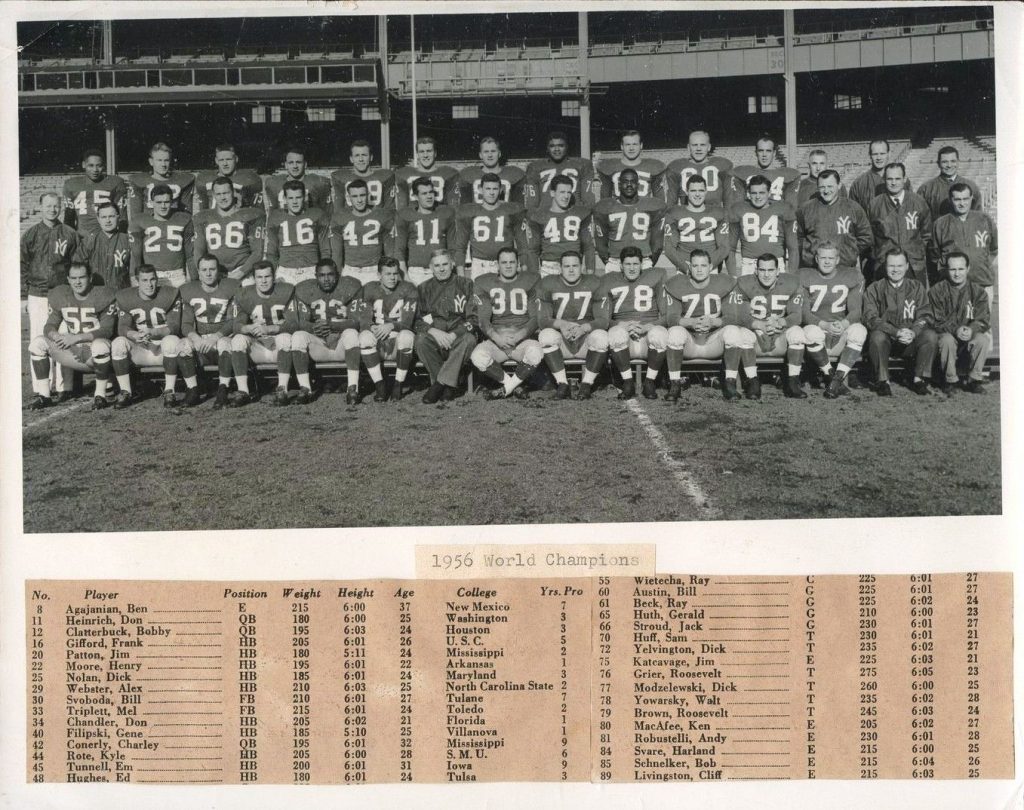
1956 New York Giants
The secondary was manned by Ed Hughes and Dick Nolan at the defensive halfback positions and Emlen Tunnell and Jimmy Patton as the safeties. A punishing tackler who possessed uncanny ball skills, Tunnell was already regarded as possibly the greatest safety and kick returner ever to play the game. Along with Conerly, Tunnell was the senior veteran in his ninth season with New York. Patton was fast and just coming into his own in his second season, and would share kick and punt return duties with Tunnell. Hughes, acquired from Los Angeles for a fourth-round pick, and Nolan selected in the fourth round out of Maryland in 1954, were both intelligent players whose intuition as to where a play was going would overcome a lack of foot speed. Their grasp of the game would translate into head coaching careers after their retirements.
The Long and Winding Road
The Giants six away-game preseason was followed up by a three-game road trip to open the regular campaign. Despite moving to a new home field an old problem followed the Football Giants. Yankee Stadium, like the Polo Grounds, was unavailable until baseball season had concluded. In their 31st season of play, the Football Giants had never opened a season at home, and normally played the first three to four weeks of each season away. Combined with camp opening in the middle of July, this meant the most of the players and coaches would be away from home two and a half months.
New York dealt the San Francisco 49ers their first season-opening loss in franchise history during a convincing 38-21 win at Kezar Stadium in front of 41,751 fans. The Giants struck early and often, scoring on their first three possessions: a 44-yard catch-and-run by Webster from Heinrich, a 59-yard rush by Gifford and a 17-yard placement by Gifford. The teams traded touchdowns in each of the remaining three quarters, with Triplett going over on plunges each time for New York. While the Giants defense surrendered 27 first downs and nearly 400 total yards in the 49ers come from behind effort, they were opportunistic, intercepting three Y.A. Tittle passes and recovering a fumble.
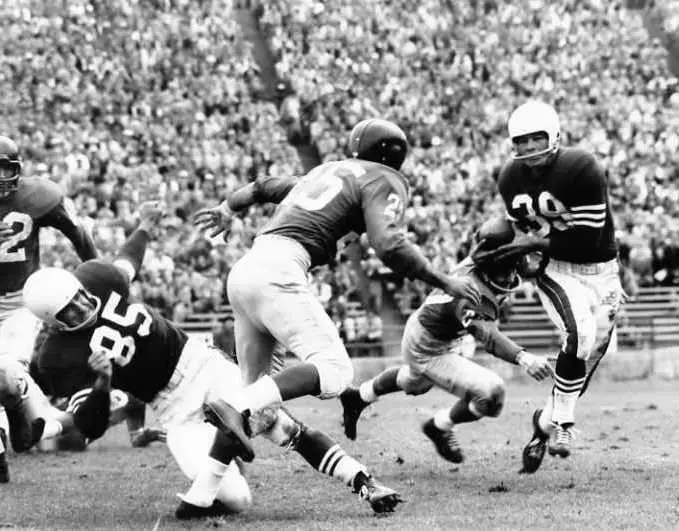
Dick Nolan (25), Jimmy Patton (20), Hugh McElhenney (39); New York Giants at San Francisco 49ers (September 30, 1956)
New York’s defense struggled the following week in front of 21,799 fans at Comiskey Park against the Chicago Cardinals. Halfback Ollie Matson had a big day rushing from the Wing-T formation and quarterback Lamar McHan completed five of seven passes for an impressive 136 yards. Harland Svare moved from this natural weak side linebacker position to middle linebacker for the injured Beck. The Giants led 13-7 but on the last play of the first half Dick “Night Trane” Lane stepped in front of Webster on a pass from Conerly in the flat and returned it 66 yards for a 14-13 lead and Chicago never looked back. Triplett had another three-touchdown game but it wasn’t enough as New York came up short in a 35-27 decision. Pat Summerall was five-for-five on point-after conversions for the Cardinals.
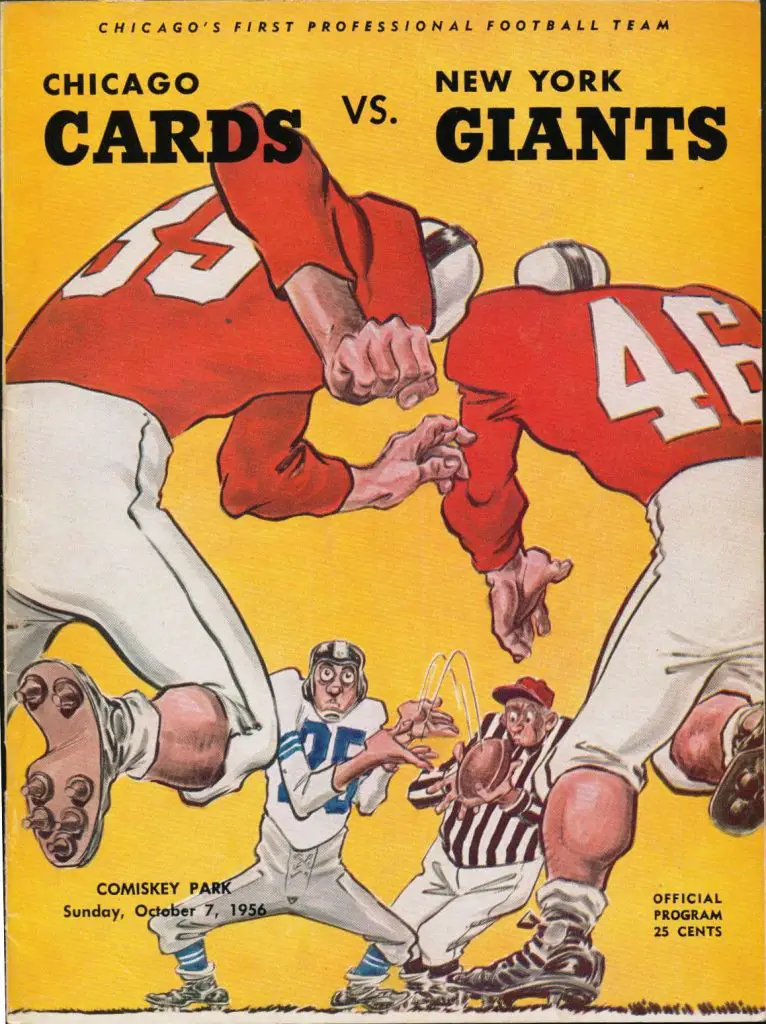
New York Giants at Chicago Cardinals Game Program (October 7, 1956)
Notable was Chicago’s use of transistor radios to relay strategic observations from the press box to the field. One adjustment call by assistant coach Charlie Trippi in the third quarter led to a blocked Chandler punt that set up a Cardinal touchdown. The Giants defense again gave up big yardage, 356 total, but had six takeaways with four fumble recoveries and two interceptions.
The following week the Giants upset the Browns in Cleveland 21-9 in front of 60,042 fans. This game is renowned for Paul Brown having his play calls over a transistor intercepted by New York. Later in the week, Commissioner Bell outlawed the use of radios on the field during league games. Andy Robustelli had six sacks for losses totaling 60 yards as the New York defense smothered the Browns attack. Most significantly for the Giants, Beck started at middle linebacker but left early. Huff stepped into the position and everything seemed to fall into place as the Giants defense never looked better. [You can read more about this game here.]
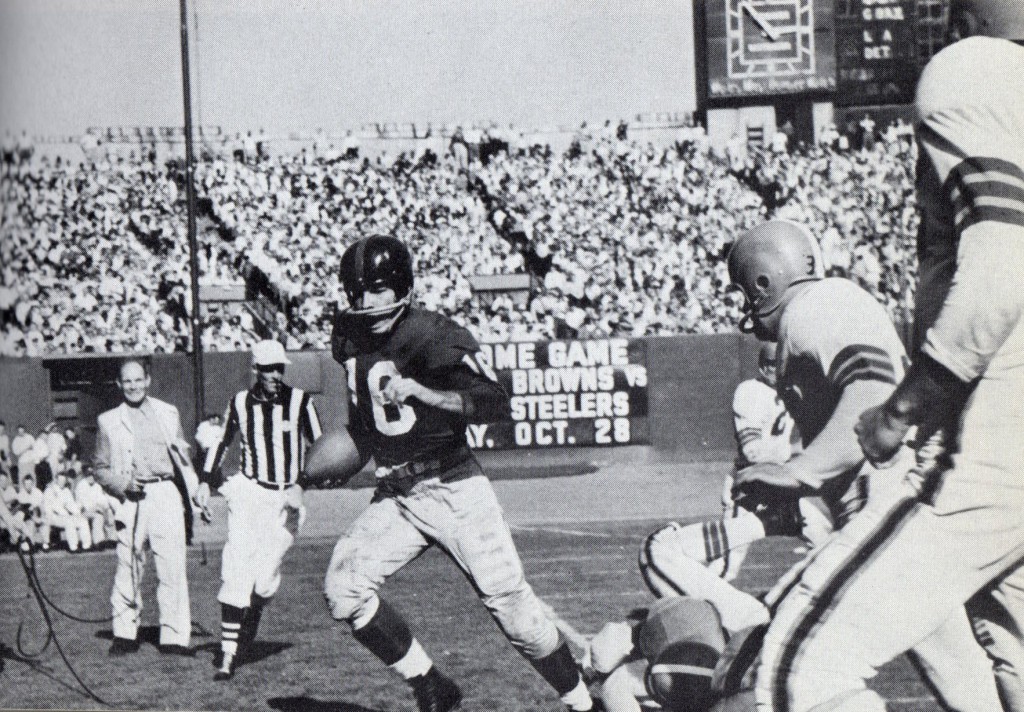
Frank Gifford (16), New York Giants (October 14, 1956)
Home Sweet Home
Four days before the grand opening of Giants football at Yankee Stadium, New York brought kicking specialist Ben Agajanian back to the team to relieve Gifford of some of his duties. The Giants staff acquiesced on Agajanian’s request to be allowed to return home to the West Coast during the early part of the week, and then rejoin the Giants on the Friday before games. The 38-year old Agajanian would handle field goal and point-after placements while Chandler retained kickoff responsibilities.
Anticipation was high following the win at Cleveland, and a crowd of approximately 40,000 was expected for the game. The 38-10 win over Pittsburgh was convincing and the local press jumped on the bandwagon, exclaiming superlatives and proclaiming intangibles. The New York Times game summary boasted: “The Giants needed about twenty minutes to make themselves comfortable in their new home the Yankee Stadium…Long before the final gun, the 48,108 spectators, marking the biggest crowd at a home-opener in Giants’ history, seemed convinced that the New Yorkers are headed for a ‘big’ year.”
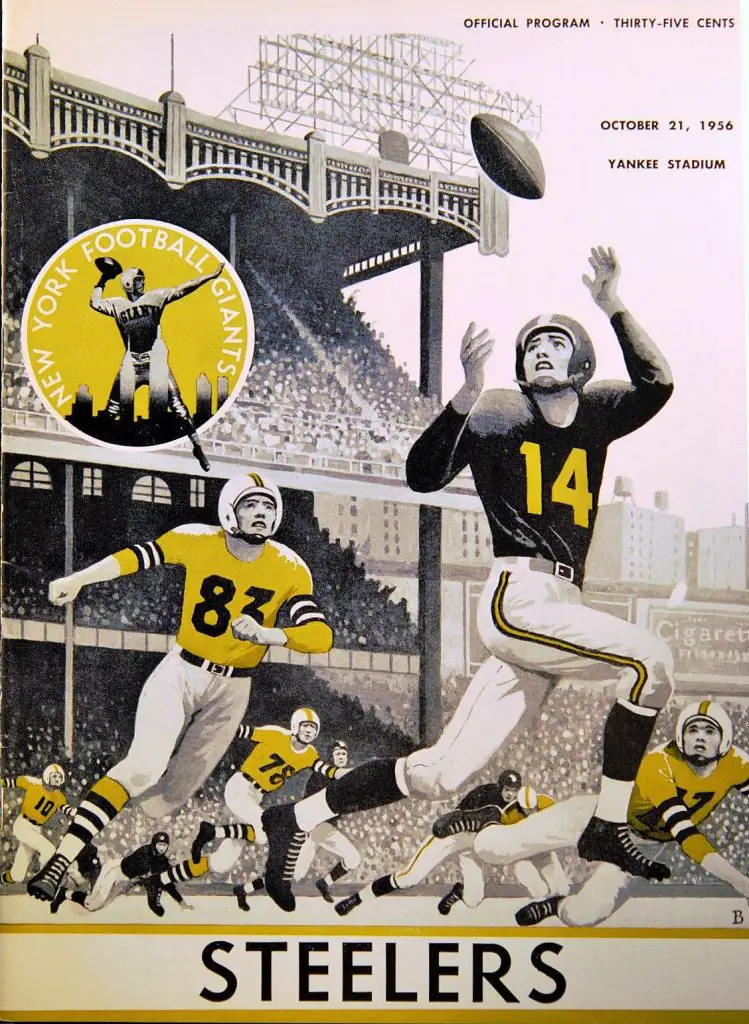
Pittsburgh Steelers at New York Giants Game Program (October 21, 1956)
The game started slowly for the Giants on offense. Once Conerly took over for Heinrich near the end of the first quarter, they became unstoppable. A 3-0 deficit became a 31-3 advantage by the end of the third quarter. New York totaled 455 yards on offense and did not turn the ball over. Conerly efficiently passed for three touchdowns and 208 yards on 14 completions in 23 attempts.
New York Times columnist Arthur Daley made an observation on the difference between the stadium’s two tenants: “The switch from baseball to football is never more apparent than in the dressing room before play begins. The Yankees laugh and joke and engage in horse play. The Giants look like men who are heading for a mass execution without any hope of a reprieve from the Governor.” Howell seemed indifferent regarding the change of venue, “Once the game started I was too busy to make comparisons.”
Gifford offered unique insight on a peculiarity of the playing surface years later: “I disliked one thing about Yankee Stadium: the field wasn’t level. If a football team was moving from the outfield toward the infield, which was elevated for drainage, the players were moving uphill. It was probably a difference of only a few inches, but, in my mind, it looked and felt like Mount Everest. On the other hand, it provided me with the perfect cop-out. Once, after I got tackled from behind after a long gain, I shamelessly told the press, ‘If I’d been running downhill rather than up, he never would have caught me.’ I was only half kidding.”
The following week the Giants defense was even more impressive while the offense sputtered. Part of the reason for the frustration was the return of an old friend – former franchise icon Steve Owen coached the Eagles defense, and he deployed a special 6-1-4 alignment to counter New York’s strengths. Despite his inability to adapt the Giants offense to the modern T-Formation during the latter part of his tenure, Owen had no peer when it came to concocting a scheme to neutralize an opposing offense’s strengths.
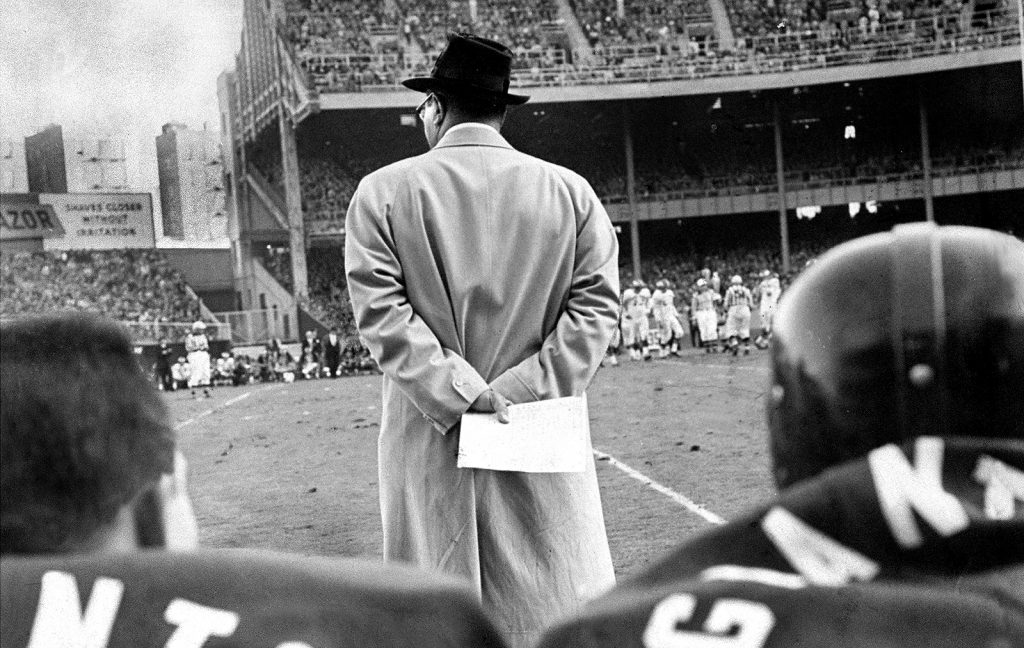
Vince Lombardi, New York Giants (October 28, 1956)
Philadelphia recovered two first half fumbles and lead 3-0 in the first quarter, but they were not able to seriously threaten the New York end zone as Landry’s Coordinated Defense wreaked sensational havoc. The New York Times game summary stated, “…the Giants had spectacular tackles such as Dick Modzelewski, Roosevelt Grier, Roosevelt Brown, Sam Huff and Walt Yowarski. These fellows never stopped charging. They spent as much time in the Philadelphia backfield as did the Eagles.”
Conerly entered the game in the second quarter with the score tied 3-3 and led the Giants to a 13-3 halftime advantage that was more than enough. The Giants defense held the Eagles to 132 total yards and intercepted two passes, and preserved the 20-3 win. New York moved into a first place tie with the Cardinals who were upset in Chicago by Washington 17-14.
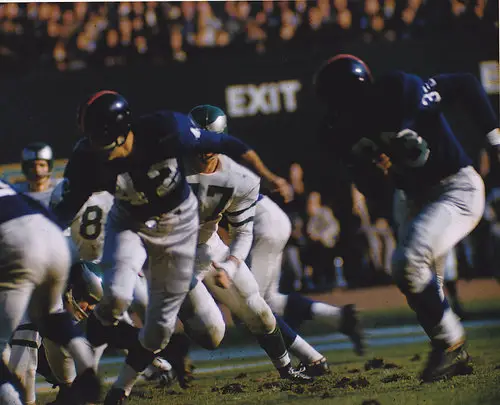
Charlie Conerly (42), Mel Triplett (33), New York Giants (October 28, 1956)
The pattern for the Giants repeated itself, a sluggish and sometimes sloppy offense was just good enough to get by, while the defense was strong and at times dominant at Pittsburgh’s Forbes Field in front of 31,240 spectators. A typical exchange in the first period saw Grier recover a fumble on the Steeler’s one-yard line, only to see Gifford fumble the ball back. New York held, but Agajanian missed a 42-yard field goal attempt. Pittsburgh outgained the Giants in total yards 255-229 but the Giants held the edge in takeaways 3-2, and pulled out a hard fought 17-14 victory to keep pace with the Cardinals who defeated Philadelphia 28-17. The two 5-1 teams would meet at Yankee Stadium the next week.
The hype for the game started early and continued throughout the week. Media coverage for the Football Giants hadn’t been this prominent or enthusiastic since the heyday of the rivalry with the Sammy Baugh-era Redskins a decade earlier. The fans were swept up the excitement, and brisk ticket sales raised hopes for a crowd upwards of 60,000. Howell declared the game a “must” for New York, given that the Giants had already lost to their division rivals, and the Cardinals had a more favorable remaining schedule. “We certainly are not in a position to be able to lose to Chicago on Sunday,” said Howell.
Tunnell spent two days in the hospital with an injured back, but was cleared to play later in the week, which was good news for Landry who needed all of his best players to stop the one player who had ripped through New York in Week Two. “Matson is a bread-and-butter back most coaches dream about. Most experts agree that he is the greatest runner in football today,” said Cardinals staff member Eddie McGuire. Former Giant great Mel Hein, who coached at Southern California, backed up the boast, “You can’t relax a second with him. Give him a foot and he’ll go all the way.”
The Apple of New York’s Eye
If the entire 91-year history of the Football Giants could be distilled down to a single moment in time where they captured the city’s heart and imagination and were finally accepted on an equal plane with their major league baseball constituents, it may very well be Sunday November 11, 1956.
Although the throng of 62,410 inside Yankee Stadium was just short of a sellout, it was the largest crowd to see the Giants play anywhere since 60,337 visited to the Polo Grounds on December 8, 1946 for a matchup against the Redskins, and was the second largest in Giants history after the 73,000 who came to see Red Grange at the Polo Grounds in 1925.
Landry devised a new defense to combat the Chicago Split-T attack that confounded New York in October. This time Huff’s responsibility was to key on Matson and determine where he would go and beat him to the point of attack. This strategy served as the prototype for the way New York would defend Cleveland and Jimmy Brown in future years.
Appropriately, the first points scored by New York came on a safety. Less than two minutes after the opening kickoff, Robustelli blocked Dave Mann’s punt and Katcavage fell on Mann with the ball in the end zone.
The game still hung in the balance through the second quarter. New York appeared to be ready to add to their 2-0 lead at the end of the first quarter until the Cardinals stopped them on downs at the one-yard line. After forcing a punt, Heinrich led the Giants to a touchdown and 9-0 advantage early in the second quarter. Then the Cardinals Lamar McHan led three successive advances into Giants territory that ultimately swung the balance of the contest. Each time Huff and the Giants defense clamped down on backs Matson and Johnnie Olszewski and forced field goal attempts. Summerall missed from 40 and 47 yards before connecting from 30. Conerly replaced Heinrich late in the period and the Giants led 9-3 at the half.
After passing New York to Chicago’s 20-yard line in the third quarter, Conerly was intercepted attempting to hit Rote in the end zone. The Giants defense forced a punt and Conerly engineered a 70-yard drive that was highlighted by a 48-yard completion to Gifford to the Cardinal’s 12-yard line. On the next play, Webster carried the distance for the touchdown and a 16-3 lead.
Following another Chicago punt, Conerly completed a 43-yard pass to Gifford to the Chicago 25-yard line. Following a few Triplett plunges, Conerly completed an 11-yard pass to Gifford in the end zone for a 23-3 advantage midway through the fourth quarter. With the outcome all but settled, the Cardinals put Jim Root in at quarterback, and he led Chicago down the field into Giants territory. Not only did the large crowd at Yankee Stadium not leave early, they zealously exhorted their passion. The bond between the fans and the Giants was galvanized in a chant that reverberates almost 60 years later. As the Cardinals advanced closer to the goal line, the New York supporters in the bleachers at the end of the field the Giants were defending attempted to impose their will and inspire the defense as their twelfth man: “DEE-FENSE…DEE-FENSE…”
Ultimately Matson scored on an 11-yard pass with 10 seconds remaining, but it didn’t matter. The 6-1 Giants were now in sole possession of first place in the Eastern Division and New York was officially a football crazed city. The defense deserved all of the adulation it received. Despite not forcing a turnover in the game (the first and only time all season) they held Matson to 43 yards on 13 carries and Chicago to 284 total yards. The Chicago Daily Tribune cited Robustelli and Grier for “excellent performances” and said Patton, Hughes and Tunnel “were stalwarts” in holding Cardinal passers to seven pass completions in 16 attempts.
This win, however, was a complete team effort. The New York Times game summary stated: “It was not only the Giants beat the team they had to beat that made so strong an impression. It was the manner in which they did it. The defense showed its usual strength and, for a change, the offense sparkled. Superb offensive blocking, missing the past two weeks, was a big factor in yesterday’s convincing triumph.” Gifford was the go-to man with 68 rushing yards and 116 receiving yards on six catches with a touchdown.
During this five-game win streak for New York, the defense surrendered just four touchdowns as the Giants outscored the opposition 119-46. Gifford said of the steak years later, “Halfway through the season we started beating teams easily, and with an intensity I’d never seen.” The normally stoic Howell boasted after the game, “This is the best Giants team in 10 years.”
An interesting consequence of two-platoon football, which was only in its seventh season of permanency, was how it divided teams into factions. Prior to that, teams were coached and practiced as a single unit. Now, not only were players identified and segregated in meetings as “offense” and “defense”, there were assistant coaches further specializing and refining their talents. The platoons ultimately assumed their own personalities. The fascination and appreciation New York fans showed for the defense was unique and unprecedented, but it clearly was the better and more consistent unit for the team, and seemed to get better with each game. The players noticed.
Gifford: “That year marked the start of the much-publicized rivalry between the offense and defense. While it never got mean, it did get intense. Probably the defense’s unprecedented fame had something to do with it. Never in the history of football had fans gone to a stadium primarily to root for a ‘DEE-fense’. The rivalry also extended to Lombardi and Landry, who, as the proud architects of their two units, in a sense created it. The one trait they shared was a fierce competitiveness, especially with each other.”
Huff: “Our defense was so good that many times we simply controlled the offense in practice, wouldn’t let them do anything. That used to get the offensive guys ticked off, and Lombardi would get so angry he’d keep the offense out on the field long after Landry had the let the defense go to the showers.”
Prosperity then Humility
If the Giants became lackadaisical in their preparation, let down their guard or simply believed they were as good as everybody told them they were, they can’t really be blamed. All of this media attention and praise was an entirely new phenomenon for them, and were unprepared to handle it. There is no other explanation for what happened the following Sunday when New York was thoroughly embarrassed in a poor effort against the 3-3 Redskins.
One single play perfectly described the woeful afternoon New York endured in front of 26,261 delighted Washingtonians. Leading 24-0 in the third quarter The Redskins brought their punt team out with a fourth-and-one on their own 36-yard line. After the snap, punter Sam Baker took off with the ball on a 22-yard advance through the completely fooled Giants coverage team to maintain possession. The drive ended with a field goal and ultimately New York lost 33-7.
Most disappointing was the inept performance from the defense, which surprisingly allowed 23 first downs and 231 yards rushing. Although three takeaways were forced by the Giants, their offense turned it over five times. Gifford and Katcavage were both injured and destined for overnight stays in the hospital with back and hip injuries, respectively. The only good news was the second place Cardinals were also upset on the road, having dropped a 14-7 decision at Pittsburgh.
The week of Thanksgiving was a busy one for New York, correcting what Howell described as “a bad day all around.” Gifford and Katcavage were both released and cleared to play. The Giants needed all 33 men on their roster for the 7-1 Chicago Bears, who held a half-game lead in the Western Division over 7-2 Detroit. While the Bears were a familiar opponent with their typically rugged outfit and powerful rushing attack, fronted by the league’s leading rusher Rick Caseras, they were different in that George Halas was not on the sidelines. He stepped aside as a courtesy to long-time associate Paddy Driscoll. Second-year signal caller Ed Brown was also leading the NFL in passing efficiency and end Harlon Hill was leading the NFL in receiving yards and yards per catch.

Chicago Bears at New York Giants Stadium Club Ticket (November 25, 1956)
The boisterous crowd of 55,191 at Yankee Stadium seemed to quickly heal whatever it was that ailed New York the previous week. The three-headed rushing attack of Gifford, Webster and Triplett slashed through the Bears front behind precise blocking. The 10-0 halftime lead stretched to 17-0, and may have been on its way to becoming even wider had Heinrich’s pass not been intercepted by Ray Smith who returned it to the New York 16-yard line. The Giants defense held their ground and the Bears kicked a field goal to close the third quarter at 17-3.
Lombardi sent Conerly in to start the final quarter with orders to keep the ball on the ground. After discussing New York’s unique dual-quarterback system with Sports Illustrated’s Tex Maul (known as “The Old Pro”), Conerly became the first Giant on the cover on the magazine the week after this game, Conerly was the subject of a feature article in the December 3, 1956 issue. He said, “You don’t see much of a game when you’re in. You’re looking for the guy you’re going to pass to or the guy you’re making a hand-off to, and you don’t see much else. I guess I wouldn’t even recognize half the guys I play against in a game if I saw them on the street afterward. They’re just a blur when they are coming in at you, and you don’t look at them again until you come out of the huddle. Then they are uniforms in a defense and you don’t see faces, just the defense.”
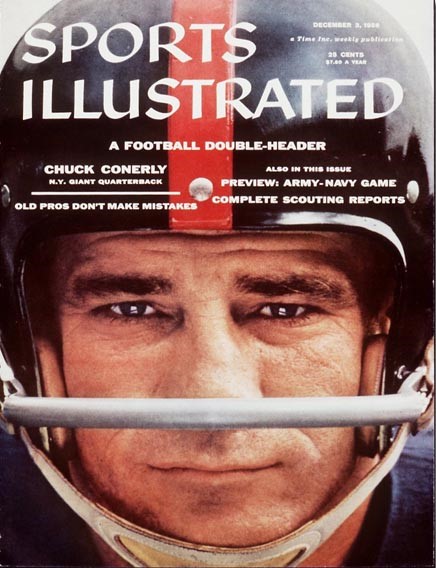
Charlie Conerly
Regarding sitting on the bench while Heinrich played Conerly said, “You don’t find any big weaknesses. It’s not like college football. Everyone is good and what you look for are habits a player develops. When you have been in the league a long time you get to know what a defensive halfback will let you do, for instance. One guy will let you throw underneath him—in front of him. The next guy covers pretty good to the outside but he doesn’t move as good to the inside, and you throw that way to him. Little things are what you look for. Like you size up the defense when you’re waiting to start the count and you see a safety man cheating a little bit toward an end you’ve got spread and you know he’s got to cover that end in the defense they have called, and he’s cheating over toward him because it will be hard for him to get there. So you call an automatic and hit the end quick.”
Conerly engineered a drive to the Chicago 22-yard line, alternating Gifford and Webster on sweeps, but Agajanian’s field goal attempt sailed wide. The teams quickly exchanged fumbles which set the Bears with the ball on their own 24-yard line with under nine minutes to play. Brown handed off to back Bill McColl, who swept toward right end, but pulled up and lofted a high arcing spiral deep down the sideline to the wide-open Hill. Giants defender Patton had released his coverage expecting the run, and the speedy Hill was unchallenged on his sprint to the end zone. George Blanda’s point-after made it a one-score game with 8:09 left in the game.
Conerly again directed a ground progression that moved the chains and took time off the clock. Chicago’s defense, which was the second-ranked unit in the league after New York’s, resisted and the Giants punted the ball back with just over two minutes remaining. Brown moved the Bears with a series of short passes along the boundaries, allowing Hill and McColl to step out of bounds to stop the clock and preserve time.
From Chicago’s own 44-yard line, Brown lofted a deep ball to Hill, who was this time covered closely by Patton. Hill tipped the ball up at the New York 5-yard line and began falling forward with Patton right behind him. Hill tipped the ball again, then cradled it in his arms as he fell across the goal line. The play was as spectacular in its artistry as it was stunning in its result. Blanda’s point-after deadlocked the game 17-17 for the final score.
“You can’t ask a boy to do much better than Patton did on that one,” Coach Howell said after the game, but he added: “Of course, he might have knocked it down or intercepted it if he hadn’t lost a step,” he said. “You just can’t make any mistakes.”
The philosophical Conerly had prophetically said to Maule before the game, “Mistakes cost you a lot more in pro ball. Back in college, a club could make a mistake and, like as not, it wouldn’t cost much. But a mistake against a pro club nearly always costs you, and usually it costs a touchdown. The mistakes in the line may not—you got the secondary to help out. But a mistake back in the secondary—that’s usually six points.”
New York’s defense mostly performed well in the game. They held Chicago’s rushing attack to a mere 12 yards and the Bears offense only generated 11 first downs and had four turnovers. The two big pass plays to Hill, who had seven catches for 195 yards and was compared favorable to Don Hutson in the New York Times after the game, in the fourth quarter were costly. The 6-2-1 Giants remained in first place ahead of the 6-3 Cardinals who beat Pittsburgh 38-27.
Lombardi cited this game later in his career as one that permanently changed his game management. He regretted his decision to have Conerly to keep the ball on the ground and play conservatively. He said, “From then on, no matter what the score was, I coached as if it was nothing-nothing.”
The Giants performance the next Sunday against Washington at Yankee Stadium in front of 46,351 fans was far from perfect, Howell commented that the contest which was filled with fumbles, miscues and missed field goals contained “more mistakes than a top game should have.” But Gifford came as close to perfection as anybody could. The star back rushed 19 times for 108 yards and caught six passes for 53 yards, and Gifford accounted for all four touchdowns. He opened the scoring with a 29-yard touchdown pass to Ken MacAfee, ran for two and caught a 14-yard scoring strike from Conerly.
Defensively the Giants returned to their mid-season form. While holding the Redskins to 75 passing yards, New York generated seven take-a-ways, including three fumble recoveries and four interceptions. Huff picked off two of the passes and the defense held Washington to only seven points. The final Washington score came on a fourth quarter 75-yard fumble return. New York’s 28-14 win ended the Redskins five-game win streak and essentially ended their hopes of catching the Giants in the division race at 5-4. The 7-2-1 Giants Eastern Division lead opened to a game and a half over the 6-4 Cardinals when the Cardinals lost to the Packers 24-21.
Over 45,000 fans were expected for Cleveland’s annual visit to New York, but an unusually weak Browns team combined with rain, snow and cold made many fans decide it would be better to stay home and listen to the game over the radio. The 27,707 who braved the elements and hoped to personally witness the Giants clinch their first divisional title in 10 years went home chilled and disappointed. The New York Times game summary even questioned New York’s championship mettle, “The impression yesterday was that the Giants will have to show marked improvement over their latest showing. Against Paul Brown’s energetic and spirited aggregation the New Yorker’s were a do-nothing, go-nowhere outfit. They seemed sluggish on defense and immobile on offense.”
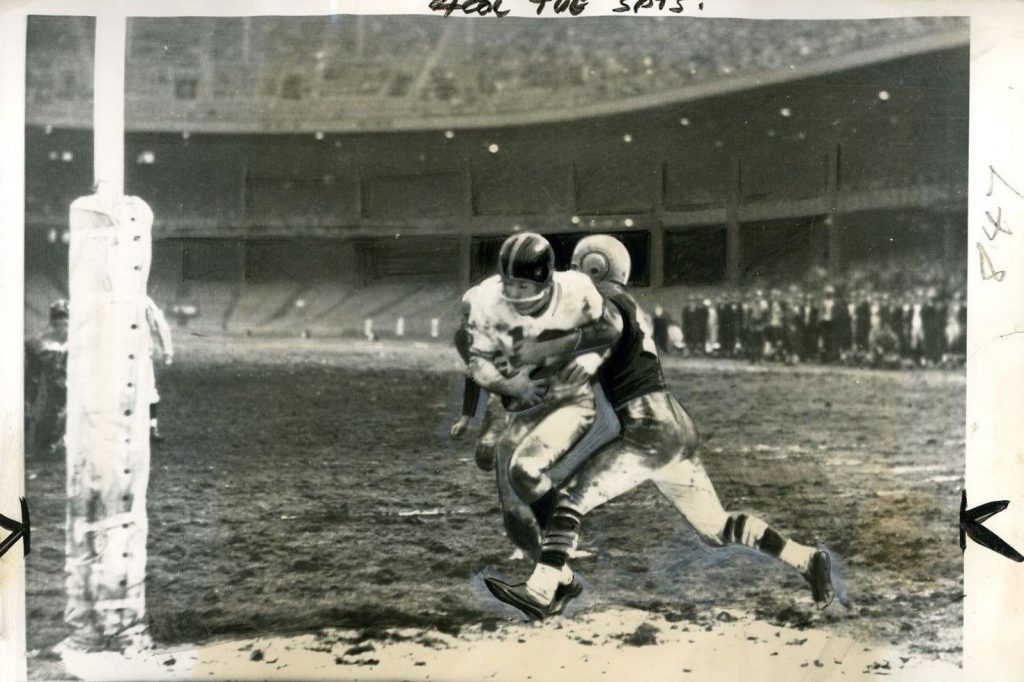
Frank Gifford, New York Giants (December 9, 1956)
A 63-yard drive that culminated in a game-tying Conerly-to-Gifford scoring pass early in the second quarter seemed to give New York life. The next possession for the Giants was a 50-yard advance into Browns territory, but Don Doll intercepted Conerly to squelch not only a scoring opportunity, but seemingly the Giants spirits for good. They never threatened again and Cleveland rolled to a surprisingly easy 24-7 win. Gifford caught six more passes and his running season total of 49 already surpassed the previous franchise mark of 47 set by Bill Swiacki in 1949.
Although the Cardinals lost to the Bears 10-3, Washington defeated Philadelphia 19-17 and had two games to play, giving them an outside chance at the title should New York and Chicago both lose their final games. However, the Giants controlled their own destiny. A win or tie at Philadelphia would wrap up the Eastern Division, no questions asked. The Giants closed out their six-game home schedule with an impressive total attendance of 280,727, far ahead of their 1955 six-game docket that totaled 163,787. Division title or not, pro football had taken a significant advance forward in New Yorker awareness.
Bad weather plagued the Northeast all week, and although Howell did not use the sloppy field conditions for the disappointing loss to Cleveland, he was upfront about his desire for improved conditions (particularly for the offense) against the Eagles: “We are a team that accomplishes more because of quickness rather than brute strength, but against the Browns we were not quick at all. We never really got started and I believe the condition of the field was an important factor. I hope we have a dry field on Saturday when we wind up against the Eagles.” Howell and the Giants spent part of the week practicing across the street at Macombs Dam Park while the Yankee Stadium field was covered by a tarp to preserve it for the potential championship game.
The Connie Mack Stadium playing surface was in good condition at game time and the Giants performance was everything their coach had hoped for. The New York Times game summary stated: “Superior offensive blocking, more certain tackling, and a clearly obvious advantage in overall speed all belonged to the Giants.” New York attempted only 11 passes and chose instead to ride the big legs of Webster, who rushed for 132 yards and a touchdown on 24 carries. Gifford also contributed 81 yards on 16 carries and Triplett 72 yards on 14 carries. The Giants led 14-0 at the half and 21-0 after three quarters. The defense was magnificent, keeping Philadelphia contained on their own side of the 50-yard line for the first 42 minutes, and barely missed its bid for its first shut out of the season when Adrian Burke completed a touchdown pass to Bobby Walston with 1:08 remaining. The Giants won 21-7.
Early Accolades
The Giants had two weeks to celebrate their first Eastern Conference title since 1946 as the NFL regular-season schedule had yet to be completed for other teams. The Giants would face an old familiar foe in the championship game: the Chicago Bears, who had also beaten the Giants in the 1946 title game. The Bears had clinched the Western conference crown in a winner-take-all brawl against Detroit. Chicago won 38-21 in a violent, fight-filled game that saw hundreds of Wrigley Field fans became part of the mayhem and charge the field during a fight between the two teams. Dozens of Chicago police officers desperately struggled to restore order before a full riot ensued.
Seven Giants were chosen to represent the 31-man Eastern Conference roster in the Pro Bowl: Charlie Conerly, Frank Gifford, Roosevelt Brown and Kyle Rote on offense and Andy Robustelli, Rosie Grier and Emlen Tunnell on defense. The All-Pro team featured five Giants: Gifford, Brown, Grier, Robustelli and Tunnell.
In the overall rankings, the Giants offense was mostly in the middle of the pack in the 12-team league. The best way to describe them would be efficient, if occasionally inconsistent. Lombardi’s unit excelled in rushing the football and not making negative plays. They ground out the third-most yards in the league (Gifford and Webster both finished in the top 10 individually in rushing yards and rushing touchdowns) and surrendered the fewest sacks and turned the ball over the least. Overall, the New York offense finished at or below average in scoring (6th), total yards (7th) and passing yards (8th)
Landry’s defense was first in fewest total yards allowed, fewest yards per rush, most quarterback sacks, most takeaways and gave up the fourth fewest points. They would need to be at their best in the championship game against Chicago, who had the league’s top rusher in Caseras (1,128 yards) and most explosive receiver in Hill (1,128 yards on 47 receptions for a 24 yards per catch average and 11 touchdowns). Hill was a nightmare for the Giants in the November game at Yankee Stadium.
Howell had the Giants spend the first of their two weeks off in the film room, specifically watching the 17-17 game, to clean up what were considered correctable errors with technique and recognition. “It’s a treat to have two weeks to get ready for a game. When you’re playing every Sunday you don’t have a chance to put much new stuff in. There are a few new wrinkles we’ve had in mind for some time and we’re taking advantage of this opportunity to go over them.” Bears coach Driscoll, who also had two weeks to prepare, was confident with his squad’s state: “The boys are in top physical shape and their mental attitude is up. There are no injuries and no signs of staleness.”
Gifford received the NFL’s “Player of the Year” award on the NFL’s final Sunday. He was the first player in history to finish in the top five in both rushing (819 yards, 5.2 yards per attempt) and receiving (51 receptions for 603 yards) and was fifth overall in all-purpose yards. He was 10th in the NFL is scoring with nine total touchdowns (five rushing, four receiving), two field goals and one point-after. He also threw two touchdown passes.
The interest in the game was unprecedented. Articles appeared in the local newspapers daily, ranging from practice updates, player profiles, to prospective strategies the two teams might feature. This served to educate the new audience to the game. Earlier in December, former Notre Dame great and former Bear Johnny Lujack wrote a lengthy feature article in The New York Times that praised the merits of the professional game over the college version. Only a decade earlier, such a public declaration would have been retorted as heresy or dismissed as nonsense.
The public a whole, however, not only was watching the pro football games on television, they were going to stadiums in record numbers. The 1956 season was the fifth consecutive that the league had set a new record at the gate. The NFL’s paid attendance in 1956 was 5,551,623, a 1.17% increase over the 1955 gate. In an interview in The Chicago Daily Tribune, Commissioner Bell said of the NFL’s spike in popularity, “Ten years ago some of our critics wailed that the pro players didn’t try. Now, it seems, the complaint is that the boys are trying too hard.” He also stated that liberalizing the passing game and free substitution were the biggest factors in the pro game attracting more fans.
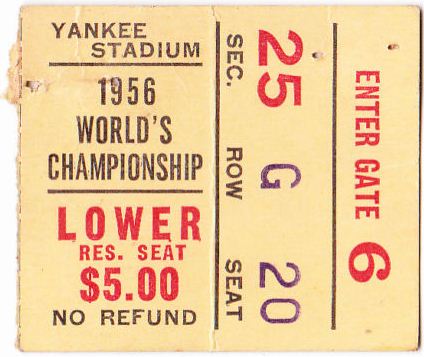
New York Giants – Chicago Bears 1956 NFL Championship Ticket Stub
Despite rainy weather the week leading up to the game and concerns over possible poor field conditions, ticket sales were brisk and a sellout was expected. The gross receipts for the game hinted at the age of prosperity the NFL had entered. The winners and losers shares would be the highest ever to that point in time. The wining team members would end up taking home $3,779.19 each and the losing team $2,485.16 each. The most significant reason for this was the NBC contract for the right to the national broadcast. The last time the Giants and Bears met for the championship in New York in 1946, the game was held in front of a robust crowd of 58,346 – which would be slightly larger than the crowd that would be at Yankee Stadium for this game. Yet, the winners and losers shares were $1,975.82 and $1,295.57, respectively. Clearly, television would be a significant factor in determining the course pro football would follow in the future.
The players were aware of this, and the day before the game they formally announced a project that had been surreptitiously in the works for three years – the formation of a players union. Their initial declaration included a list of six demands, which in retrospect were modest and not unreasonable: (1) league recognition of the union; (2) compensation, including per diem, for attending training camps; (3) injury compensation; (4) $5,000 minimum player salaries; (5) a pension program; and (6) clubs – not players – paying for equipment. Rote was the representative for the Giants, and eleven of the twelve teams were accounted for, excepting the Bears whose players declined recognition either out of fear or respect for Halas, a founding member of the American Professional Football Association (APFA) in 1920.
The Bears were considered the favorite to end the championship drought for the two old rivals. Chicago last won a championship in the 1946 game against the Giants and New York hadn’t won since 1938.
The Big One
Not unlike the first championship meeting between the Giants and Bears in New York in 1934, the weather turned extremely cold during the overnight and the field was completely frozen. The overnight temperatures plummeted during the night and was 26 degrees at game time and winds reached 30 miles per hour. Halas’ son-in-law Ed McCaskey said, “It was the coldest I had been in my whole life. We attended `My Fair Lady’ the night before, and as we left the theater, an ice storm set in. The next day, the field was a mess.”
Recalling the 1934 championship game which took place under similar circumstances, Robustelli had 48 pairs of brand new basketball sneakers delivered to Yankee Stadium that morning. Howell had several players try them out on the field alongside players wearing cleats. The players with the sneakers demonstrated superior traction on the slick surface while the players in cleats slipped and fell. The decision on equipment was easy.
Chicago had brought along sneakers as well, but they were of an earlier vintage. George Connor recalled, “We had poor sneakers with little rubber cleats. I know they were old: one pair had Bronko Nagurski’s number 3 painted on the heel. I guess they were the same ones Halas ordered after the 1934 sneakers game … The rubber was starting to crack, they were so old.“ Bears coach Driscoll said, “Those sneakers were better than ours. Their soles were thicker than our soles. This helped their footing greatly.”
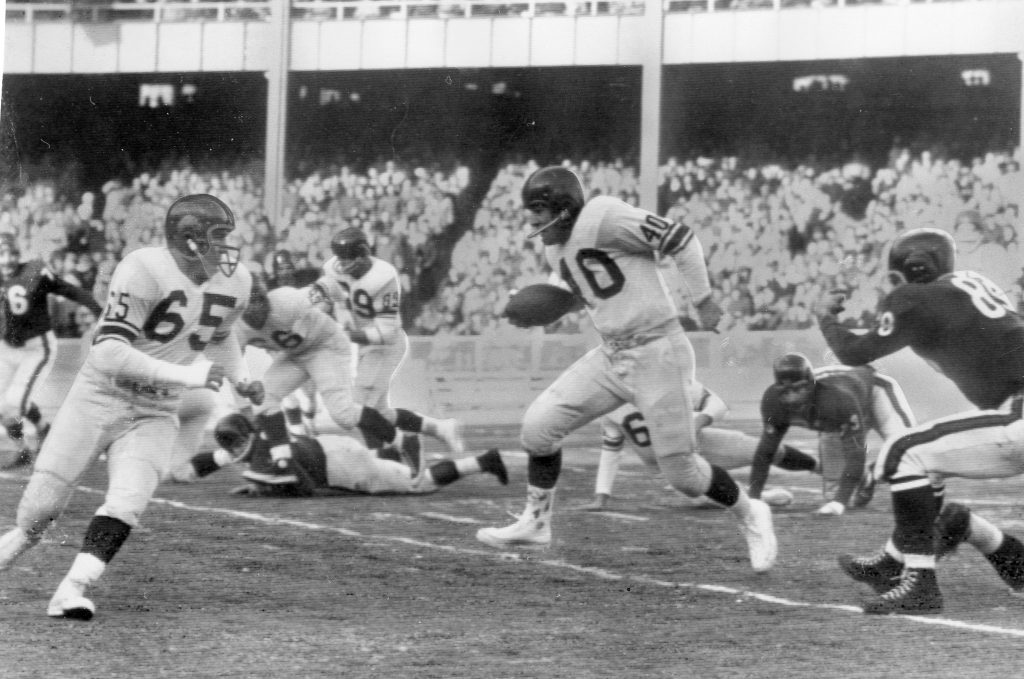
Gene Filipski (40), New York Giants (December 30, 1956)
The difference in footwear was apparent from the very start. Chicago kicked off and Gene Filipski returned the ball 54 yards giving New York possession in Bears territory. Four plays later Triplett rumbled through a huge hole in the line, trucked would-be tacklers and bowled over an official on his way to a 17-yard touchdown and 7-0 lead. Lombardi said, “That run by Gene gave the team its opening spark. From then on, it was a solid effort from each and every man.”
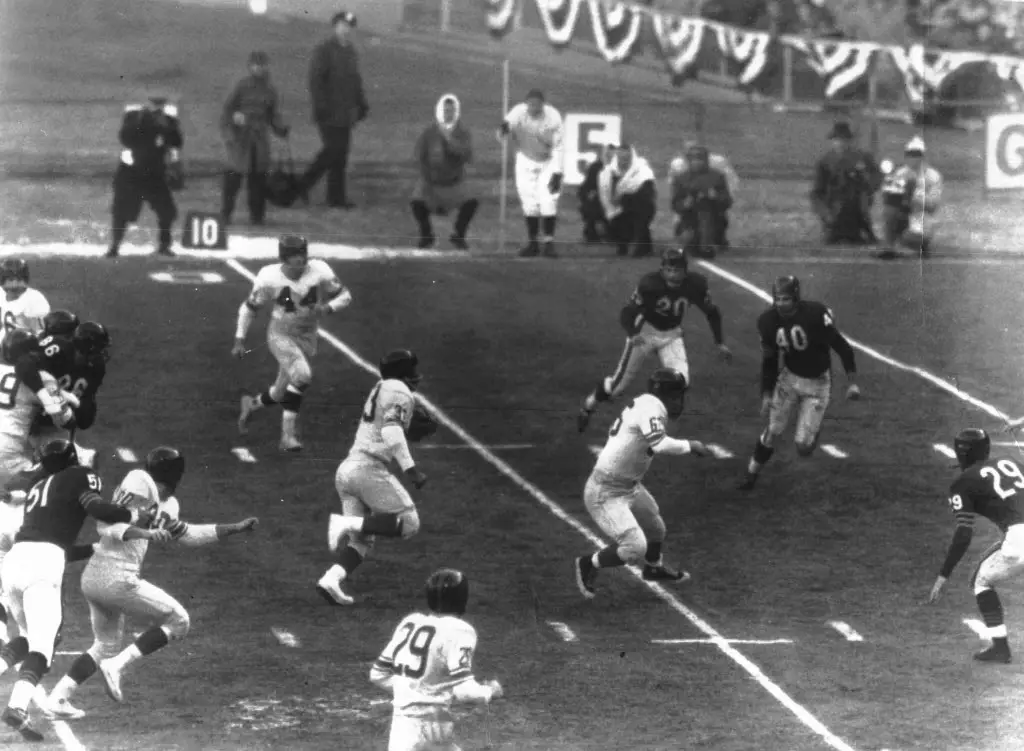
Mel Triplett running for a touchdown; Chicago Bears at New York Giants, December 30, 1956 (1956 NFL Championship)
New York’s defense made the next contribution when Robustelli recovered a loose ball on a botched exchange between Brown and Bobby Watkins on the Chicago 15-yard line. Three rushes netted four yards and Agajanian booted a 17-yard field goal. After ten total plays from scrimmage, New York led 10-0.
The game summaries from the major newspapers of both cities described the one-sided affair:
- Chicago Daily Tribune: “The mighty Chicago Bears came into a cavernous deep freeze called Yankee Stadium here today and left as football’s greatest enigma, humiliated by the New York Giants 47 to 7 in the National league’s 24th annual championship playoff.”
- New York Times: “The manner in which the Giants ran, passed, kicked, scored and defended against the Western Conference rulers shocked most of the 58,826 half-frozen fans watching the playoff game.”
Patton intercepted Brown on an overthrow of Hill that led to another Agajanian field goal. The score was 13-0 as Conerly took over for Heinrich at the end of the first quarter. Conerly hit Webster on a 24-yard gain to set up a three-yard plunge by the big back for a 20-0 lead before the second quarter was three minutes old. The relentless Giants were dominating in all three phases of the game and the Yankee Stadium crowd was delirious.
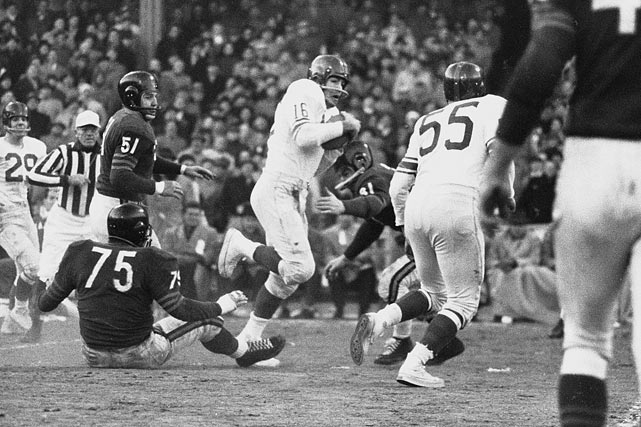
Frank Gifford (16), Ray Wietecha (55), New York Giants, 1956 NFL Championship Game (December 30, 1956)
Chicago had one break that gave them a chance to stymie New York’s onslaught and get back into the game. The Giants defense held the Bears, but Tunnell fumbled the punt and Chicago recovered at the Giants 24-yard line. Four plays later Caseras ran for a touchdown to cut the lead to 20-7. However, Conerly guided another long advance that closed with a Webster one-yard plunge for a score.
J.C. Caroline mishandled the ensuing kickoff and Chicago began the possession at their 10-yard line. New York’s defense threw the Bears for losses on three consecutive plays, setting up a punt from the two-yard line as Yankee Stadium roared: “DEE-FENSE…DEE-FENSE…” Ray Beck sliced through the line and blocked Brown’s punt and rookie back Henry Moore fell on the ball in the end zone. The Giants were in command 34-7 at halftime.
The Bears replaced Brown with Blanda and switched from the T-Formation to the Short Punt formation where Blanda essentially operated as a tailback. The results were the same, New York’s defense was stifling and their offense ground away yardage with their three backs. Conerly attempted only 10 passes but was deadly accurate, completing seven for 195 yards and two touchdowns. The Chicago passers combined for 20-of-47 for 237 yards and two interceptions.
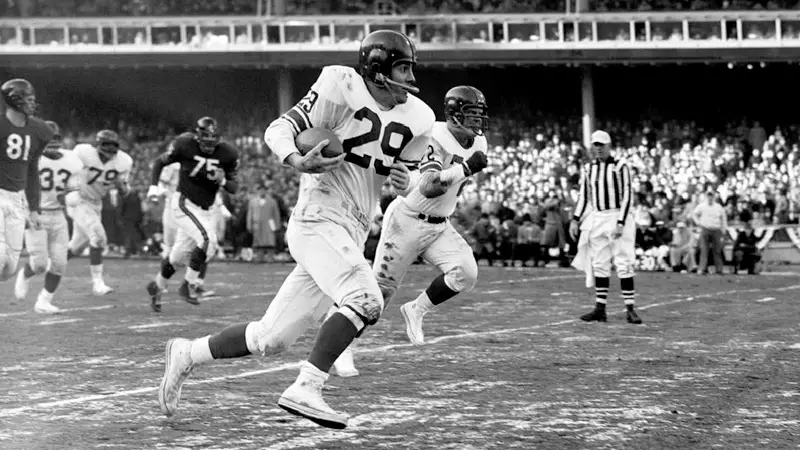
Alex Webster (29), Dick Yelvington (72), 1956 NFL Championship Game
The Giants added 10 more second-half points, and several hundred fans who remained in the frigid stadium stormed the frozen field and tore down the goal posts, celebrating the emphatic 47-7 victory and the Giants first championship in 18 years.
Caseras told the Chicago Daily Tribune, “They smashed us from start to finish…The Giants play that winning brand of football: hitting you hard on one play then hitting you harder on the next. We were really confident when we started, but they got ahead so quickly, and did it so easily, we couldn’t play our regular game. We were outplayed, terrifically outplayed.”
Howell said before the start of the game that he was concerned that his team was too relaxed, but that concern was unwarranted once the game started, “They just wanted to play – they wanted the championship.”
Chicago quarterback Brown said the Bears were too tight and possibly exhausted, “We were over-trained. We only had one day off—Christmas Day—preparing for this. What the hell—the Giants got five days off. We were just too tied up.”
Whether the differing philosophies in preparation were at the root of the outcome did not matter to Commissioner Bell who said, “In all the time I’ve been watching pro football, I’ve never seen the Giants as hot as they were today.”
The End of the Beginning
The 1956 Giants not only brought pro football to the forefront of the greater New York area, but the entire NFL came along for the ride. Soon pro football players transcended the confined orbit of the sporting world and crossed over to mainstream America.
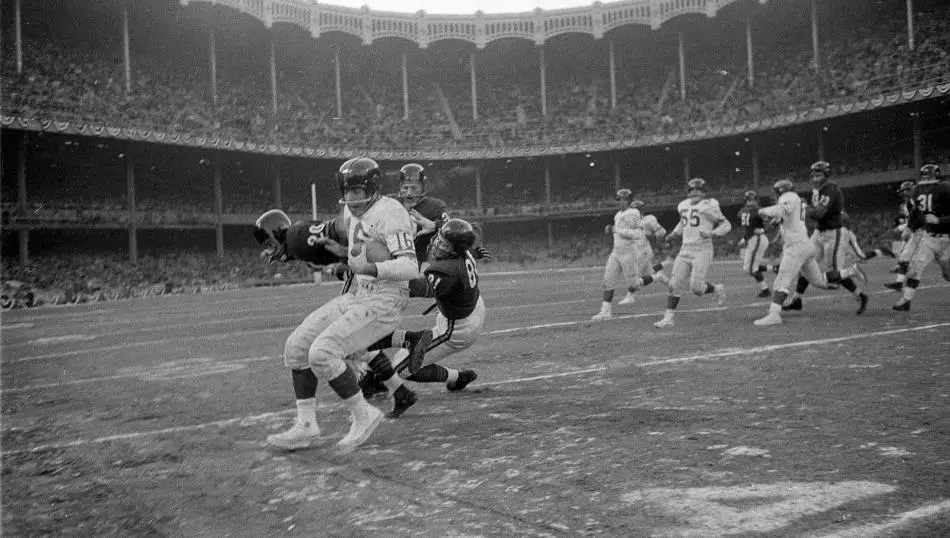
Frank Gifford (16), Ray Wietecha (55), 1956 NFL Championship Game
Gifford recollected, “I’ll always believe that that game (the 1956 NFL Championship) was the key to the development of the NFL today. People forget what the NFL was like in those days. It was not America’s number one sport. But once we played the game, we became heroes in New York. The thing just grew from there.”
The names of the Giants players from this era are still remembered fondly nearly 60 years later, even by fans who are too young to have seen them play, because they are still featured in archival footage from NFL Films. Five players from the 1956 Giants are enshrined in the Pro Football Hall of Fame: Tunnell (1967), Robustelli (1971), Brown (1975), Gifford (1977) and Huff (1982). One other remains on the outside looking in. “Charlie is the best player who is not in the Pro Football Hall of Fame,” late owner Wellington Mara said of Conerly on many occasions. “He has better numbers than some quarterbacks who are there.”
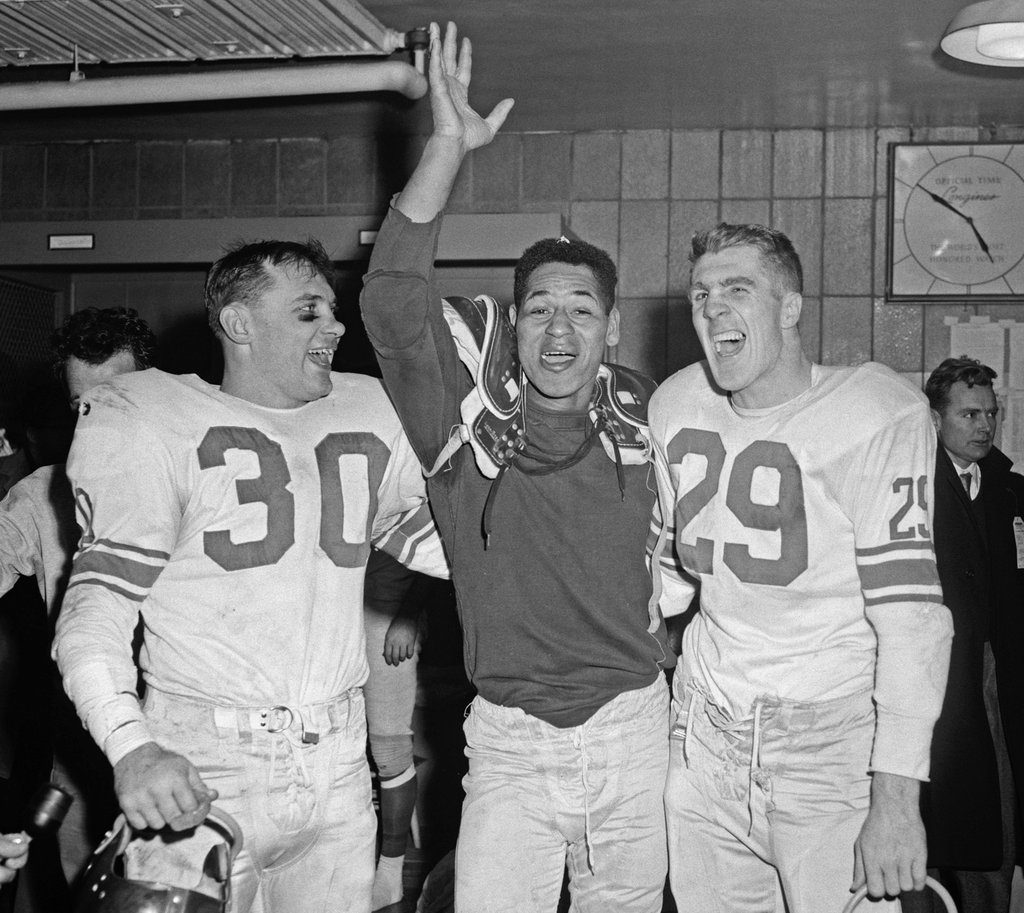
Bill Svoboda (30), Emlen Tunnell (middle), Alex Webster (29); (December 30, 1956)
Conerly being on the cover of Sports Illustrated in December 1956 was a big recognition at the time, but paled in comparison to Sam Huff being on the cover of Time Magazine in November 1959. Players were being so wholeheartedly embraced by fans that Madison Avenue took notice and exploited the public’s new love for football. The NFL’s new heroes were paid handsomely to endorse products and services nationwide. In New York, Rote hosted a weekly radio program and Gifford televised the sports segment on local news during the offseason. In 1960, Huff became a national sensation when he was featured in a 30-minute documentary hosted by Walter Cronkite titled “The Violent World of Sam Huff.”
More immediate dividends were reaped by the Giants who sold out every home game for the 1957 season, the first time that ever happened. A cottage industry erupted around the Tri-State area as local hotels and restaurants advertised Giants games on television outside the 75-mile radius of the blackout zone. New Yorkers began traveling to eastern Long Island and southern Connecticut to pick up the broadcasts from the Hartford affiliates and south New Jersey to pick up the Philadelphia affiliates.
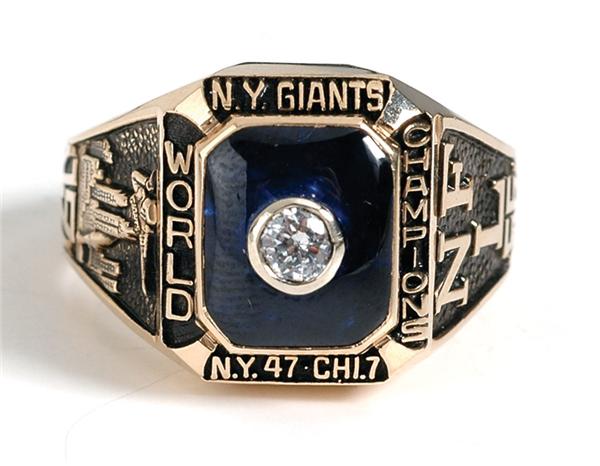
New York Giants 1956 NFL Championship Ring
The public’s insatiable appetite seemed ready to be sated following the 1958 NFL Championship game between the Giants and Baltimore. The thrilling game captured the imagination of not only the 64,185 fans inside Yankee Stadium, but the record 42 million fans nationwide who watched the telecast on NBC.
Only months after that game, a group of entrepreneurs, headed by Lamar Hunt, approached the NFL about expansion and inclusion into the burgeoning league. After being rebuffed several times, the group started their own league, the fifth to challenge the NFL since 1926 and the fourth one to be called the American Football League. This one, however, had staying power and helped continue the pro game’s evolution by sparking the creation of the Super Bowl in January 1967 and NFL-AFL merger in 1970.
SOURCES:
“Pro Football – Parasite or Paragon?”
George Cullicott, Sep. 1956, Sports Review Football 1956
“The Titans Were Tied”
Tex Maule, Dec. 3, 1956, Sports Illustrated
“Notes On A Gelid Afternoon”
Tex Maule, Jan. 7, 1957, Sports Illustrated
New York Football Giants 1957 Press, Radio and Television Guide
Robert Daley, 1957, New York Football Giants, Inc.
National Football League 1957 Records and Rules Manual
Joseph T. Labrum, 1957, The National Football League
New York Giants
Don Smith, 1960, Coward-McCann Sports Library
The Giants of New York: The History Of Professional Football’s Most Fabulous Dynasty
Barry Gottehrer, 1963, Putnam
The First 50 Seasons
Bob Oates Jr., 1969, Ridge Press
The Encyclopedia Of Football – 16th Revised Edition
Roger Treat, Suzanne Treat, Pete Palmer, 1979, A. S. Barnes & Co.
Illustrated History of the New York Giants: From The Polo Grounds To Super Bowl XXI
Richard Whittingham, 1987, Harper Collins
Tuff Stuff
Sam Huff, 1988, St. Martins Press
The Whole Ten Yards
Frank Gifford with Harry Waters, 1993, Giff & Golda Productions
From Sandlots to the Super Bowl: The National Football League 1920-1967
Craig R. Cowenen, 2005, The University of Tennessee Press
Historical New York Times Searchable Archive (via ProQuest)
Google News Historical Archive
The Pittsburgh Press
